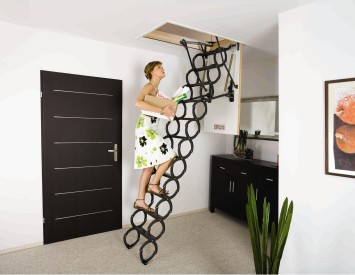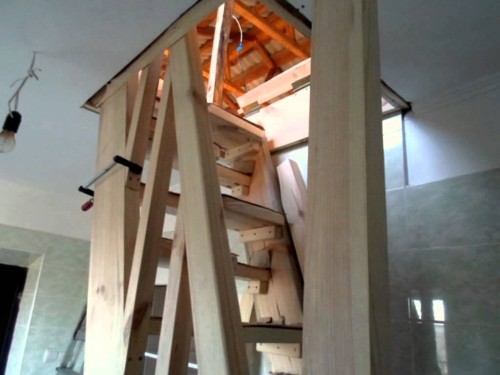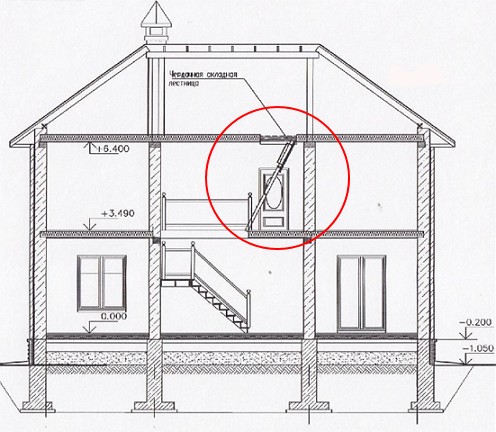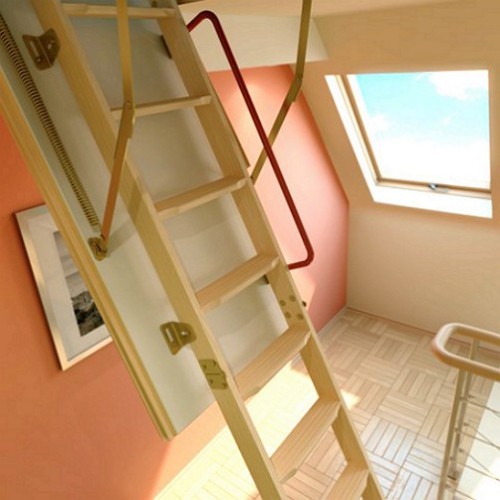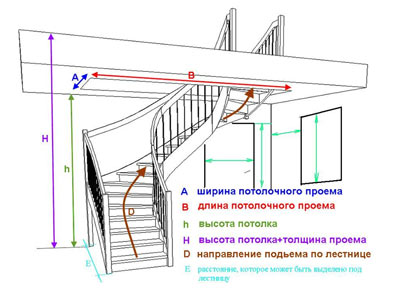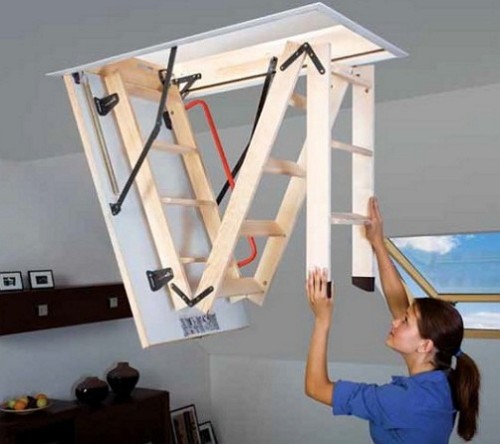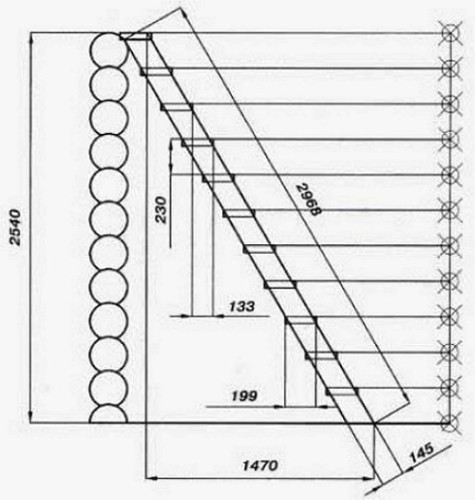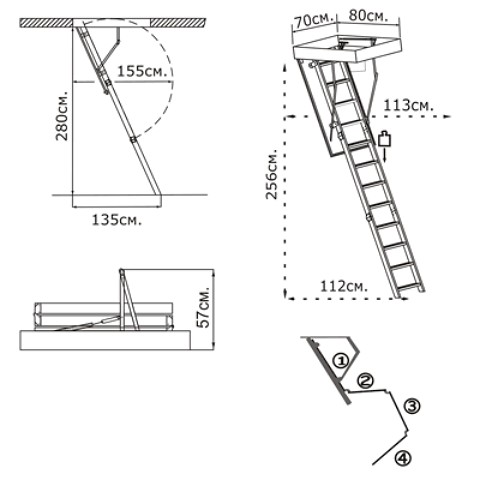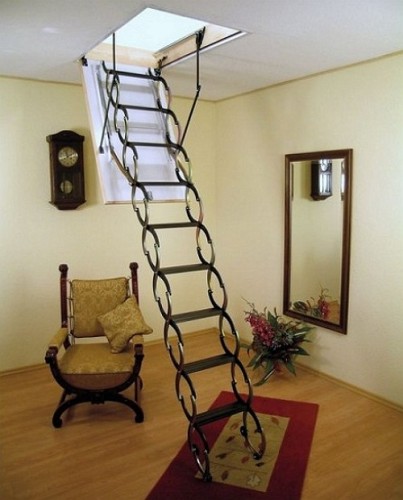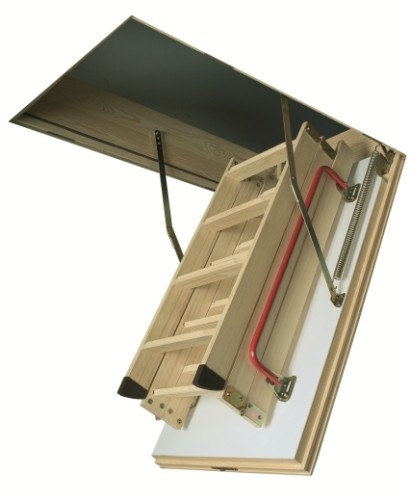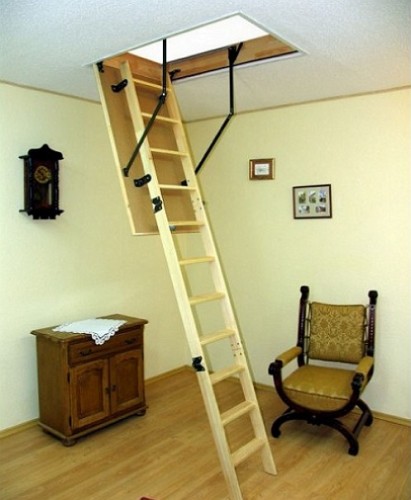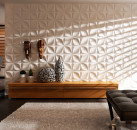Private houses usually have attic premises that require the presence of a staircase. Moreover, if earlier the staircase to the attic was a rather bulky installation, today it is mobile and practical. In addition, such designs are compact, functional and do not require large installation costs. They can easily be made independently.
Sadržaj
The main characteristics
If not so long ago, attics were mainly used in order to add various unnecessary things here. Today they are equipped with working rooms, rooms for children and other premises used for household needs. What has not changed since then is that to climb the attic you need to build a staircase. A more convenient way to go upstairs has not yet been invented. However, before you decide which attic staircase, you need to learn more about all possible options. In this case, it is necessary to understand the procedure for their installation and use. Only after that can you make a final choice.
The following types of stairs are distinguished by the configuration:
- folding,
- screw,
- scissor,
- telescopic,
- sliding,
- automatic.
When it is required to install the stairs, then most often, a manual and automatic method is used for layering.
By the location of the stairs there are:
- external,
- internal.
Such attic structures are installed both inside the house and outside. In the latter case, the staircase leading to the attic is usually placed on the outside of the wall. However, it is more convenient to arrange it still inside the house. After all, it is likely that it will have to use it when it is cold outside.
The staircase in the house on the attic should not create inconvenience. Therefore, do not place it in the kitchen or in the living room. A more suitable place for location is a corridor or hallway. Although, if they rarely use the attic, then you can place a folding staircase even in the living room. Only for this you will need to highlight a special zone. You should also equip a place where it will be possible to “hide” the structure in folded form. If the staircase serves as an element of the interior than some kind of functional detail, then it is better to leave it open.
One of the most convenient is a folding staircase to the attic. It has a lot of advantages. In particular, just manufacture and install it. In addition, it saves space. But this is not the only possible option. If the area of \u200b\u200bthe attic allows, then you can install a retractable staircase in the attic. She will move along pre -made furrows.
A telescopic staircase is also considered quite convenient, but it is rarely used in private houses. It can more often be found in industrial premises. The fact is that it is very difficult to make such a staircase with your own hands.
Selection of materials
If you decide to make a wooden staircase in the attic, then it is best to work with a material that is not yet painted so that after installation you can paint the structure with your own hands, given the rest of the interior palette. Most often, wooden stairs are made of a massive pine. However, the tree is recommended not as the main frame, but as a decorative insert. However, the wooden staircase to the attic to assemble it with your own hands is still much easier than made of metal. Indeed, for metal structures, a processing method is required, not always possible at home.
If you decide to build a metal folding staircase into the attic, then you must first know that in the process of work the design should be covered with galvanizing to protect the material from corrosion. Metal stairs to the attic are very durable and at the same time occupy less space than wooden. This saves space.
There is no alternative to metal yet. To prevent friction of metal parts, plastic elements are additionally used. To prevent side sliding, use plastic inserts.
Requirements for stairs
There are several important requirements for attic stairs. So, the most important point is the convenience of use and safety. Although, in fact, these two requirements also imply several secondary characteristics of attic structures. They, in particular, are the type of stairs, the width of the steps, the height of the rise, mobility and compactness. These parameters must be thought out in advance. At the same time, first of all, it is necessary to mount and install the design so that it complies with safety requirements.
The sizes of the stairs to the attic
First, imagine the future design in the finished form. Estimate what parameters and characteristics it will have. If you want to install a folding staircase, then you need to roughly outline the dimensions of the entire structure in disassembled form. So that she can fit into the size of the room, it is necessary to calculate the height of the opening and know the height of the ceiling. You also need to think over secondary sizes. The results should be used in compiling the drawings of the future structure.
The sizes of the steps must be chosen so that an adult can easily climb the stairs. The average value is approximately 640 mm. Another important role in the correctness of the manufacture of the future staircase is played by the way the steps are located. So, they should not be located too far from each other. In addition, it is important that they are in parallel relative to the floor.
For safety reasons, it is recommended to use stable and wide stairs. At the same time, the width of the flight should be at least 0.9 m. It is important that the angle of inclination of the stairs is observed during installation. This parameter should be approximately 50 degrees.
The shape of the attic staircase
Stairs to the attic can be of any shape. The most important thing is that the attic structure is reliable and at the same time compact and convenient to use. It is advisable to choose the configuration of the stairs, which is most suitable for the interior of the house. So, for example, for a small room it makes no sense to put a massive staircase that takes up a lot of space. In a large room, you can put structures of almost any shape.
The staircase can have one, two or three marches. The choice of one of these options depends on the size of the free space and on the wishes of the owner of the house. So, the simplest design is considered a single -march staircase. It is usually used if between the lower floor of the main building and the attic a difference is not more than 2.7 m. It is worth saying that such a simple, at first glance, design can be built in a special way. For example, a single -march staircase in the attic can have an ardent shape. Its steps can be made in the form of diverging rays. In addition, a unique interior can be created using a screw attic staircase.
When deciding which design of the stairs to choose, you need to take into account the height at which it should be installed. This parameter depends on the total height of the ceiling. In addition, you need to take into account what the size of the opening in the ceiling.
DIY staircase
If you have a little experience in such work, then for starters it is advisable to opt for the simplest design. For example, you can build a two -section folding staircase. The manufacture of a staircase usually begins with the necessary measurements. The angle of inclination is selected by the type of room, but most often it is about 40 degrees.
To calculate the length of the stairs, you need to take into account the angle of its inclination and the height of the ceilings. So, if the angle is 40 degrees, and the height of the ceilings is 2.5 m, then the length of the stairs should be about 3 m. It is advisable to mark all this in the drawing drawing.
In the manufacture of stairs, it is usually required:
- Boards for the manufacture of steps.
- Bars for staircases.
- Folding suspensions. They will not give the hatch cover to close.
When all materials are prepared, you can proceed directly to the manufacture of the attic structure. When performing work, be sure to take into account the height and width of the stairs. In addition, you need to take into account the number of steps that are attached on both sides by means of self -tapping screws or glue. On the steps, you need to attach the overlays in any way that will prevent sliding.
Stages of manufacturing the attic structure
So how to make a staircase in the attic? All work on making the structure can conditionally be divided into several main stages:
- All work is performed in the direction from the bottom-up. First of all, special beams are installed. Then we check how firmly the hatch box is fixed.
- Next, installation work is carried out. First, on the inside of the hatch, a flat line and points where the plates will be fixed are fixed. Then, on one side of the hatch, the plate is fixed.
- When the staircase lies in place, you need to strictly hang out points for screws located on the back.
- Then, parallel to the hatch in the ceiling, the plates are attached. Next, the staircase itself is inserted between them. Then, through the holes made in the plates, the design is fixed with screws.
- Further, with each other, two parts of the attic staircase are joined by articulations.
- At the next stage, you can proceed to adjustment. First, you need to make sure that the fixed parts of the stairs located on the hatch are strictly parallel to each other.
- Then you should check how the hinge connection works. Finally, you need to coordinate the length of the stairs to the attic with the height of the ceiling by sawing off the excess from below. By the way, the larger the angle of inclination of the structure, the more it will be pressed on the ceiling and to the places where the hatch will be attached. It is best when the pressure is almost absent, but the staircase applies to the floor surface.
- When installing the attic structure, it is recommended to choose an angle convenient for lifting. Moreover, its value should be as close to 80 degrees. As practice has shown, most often the most suitable angle of inclination is 70 degrees.
- There is very little left. It is necessary to adjust the heights in addition to the side corners. Then fasten the side staircases.
- Next, you should fix the entire structure under the opening in the ceiling. Several bars are interconnected by loops. The boards should be in width equal to the dimensions of the stairs. Separate elements are assembled using furniture fittings. Moreover, if the loops are used, then their performance must be checked before finally twist the fasteners. Note that a lock of work may differ.
This design is considered one of the simplest. Therefore, there should be no problems with its device. There is another version of the attic structure. For this, not one, but two short stairs of the same length are made. Then they are interconnected by steel mechanisms. A similar staircase will be installed directly on the hatch. If necessary, climb the attic, it is laid out manually. When a drawing of such a design is compiled, you need to calculate the mass of the attic staircase and the number of fasteners to fix parts.
Staircase to the attic: photo
